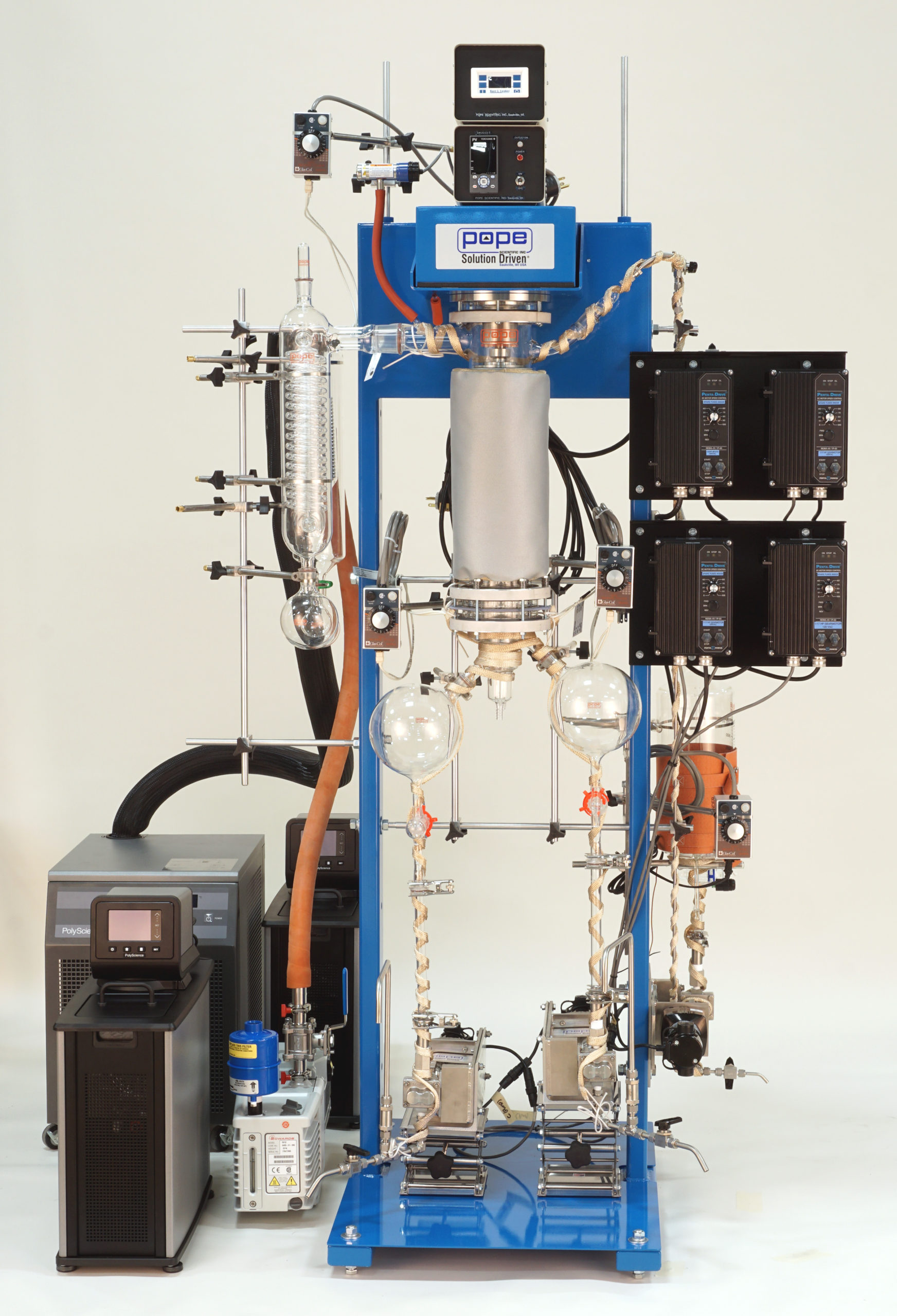Although distillation often gets lumped in with extraction, it’s actually the step after extraction, a process that refines the raw oil, removes impurities, waxes and other undesirable elements, like chlorophyll. It turns the extract from the viscous material often used for dabs into a clearer, flavorless, high-potency oil for use in cartridges, tinctures and edibles.
The process also decarboxylates the material, changing the THCA found in the plant into what is generally referred to as “active” THC, and raising the percentage of THC or CBD to levels above 90%.
“The color and the quality of the oil is better,” says Chris Barone, chief science officer at Clear Cannabis. “Purity, potency, color, odor — all that stuff — is brought up to a higher level.”
An Old Process
Distillation itself is an old process, one used in many industries, but most notably for making alcohol. Traditional short-path distillation, like that of an old moonshine still, uses a boiling flask to heat the material so it evaporates and is caught on a condenser above. The mash is heated in the flask and the alcohol boils off first. It begins to cool when it hits the condenser and then drips into a collection vessel, leaving the water and other substances behind.
“In that case, you’re driving ethanol off,” explains Dean Segal, vice president of sales and marketing for Pope Scientific.
While this style of distillation was used in the early days of the cannabis industry, boiling the materials for hours at a time degrades the very cannabinoids that the process seeks to distill, resulting in less purity and less yield.
“This problem goes way back to the ’30s and ’40s, when people were starting to distill vitamins and pharmaceuticals,” Segal says.
The solution was lowering the pressure in the chamber.
“Molecular distillation, from a chemistry perspective, is a physical process that relies on heating up the liquid or the resin to its boiling point and separating the constituents of that mixture based on boiling point,” Barone says. “Specifically, molecular distillation is doing it at a substantially reduced pressure.”
The idea is to use a high vacuum to help increase the space between molecules so that they can be boiled and separated at a lower temperature than usual, ensuring a better final product.
“We would normally have to heat to, say, 400 degrees Celsius, but when you pull a vacuum on it, it will distill at, say, 200 degrees Celsius,” says Barone. “That means what would normally decompose or be ruined or have bad flavor won’t happen under these circumstances.”
“What we’re doing is we are trying to separate the cannabinoid profiles away from the non-constituents, whether they be heavy metals or chlorophyll or even terpenes,” explains Cory Balma, senior technical director for Root Sciences. “We are trying to gather the cannabinoid profiles without degrading them, while leaving all of the non-constituents behind.
“We’re running this through an apparatus to lower their boiling point, separate them on a molecular level and recondense them and capture them in their purest forms,” he says.
“That’s the cool part about molecular distillation: the ability to distill heat-sensitive compounds,” Barone says.
Modern methods
Modern distillation machines, like those made by Pope Scientific, distributed by Root Sciences and used by Clear Cannabis keep the temperatures lower, the path shorter and heat the material quicker to prevent it from burning. They also use a continuous, wiped film mechanism to keep the residency time inside the vessel as short as possible to accelerate the process and prevent further degradation.
“You have very high efficiency of the wipers wiping around and mixing a very thin film on the wall on the way down, so it allows evaporation in a very short time,” explains Segal.
Segal says Pope’s machinery goes beyond traditional molecular stills in that they can include internal and external condensers, allowing for different uses and types of collection.
“We have designs where we can combine both the internal and the external, and what’s nice about that is that when you are distilling away your terpenes at first, you can collect your terpenes at both the internal and external condenser. And these different groupings of terpenes, they are like two different products you can collect and utilize,” he says. “It also gives you a lot of efficiency.”
Segal says the internal and external condensers on Pope stills can be used interchangeably. Pope also offers two different types of heating — electric and oil jacket heating — to give users more leeway and choice. It also offers multiple-stage stills and turnkey systems that can be up and running in no time.
Root Sciences partners with German manufacturer VTA to distribute that company’s wiped film stills. Root Sciences also uses that equipment itself to refine cannabis for use in multiple products sold in its home state of Washington.
“Once you have a distillate, you can make a lot of products,” Balma says.
Clear Cannabis was one of the first in the country to use molecular distillation for cannabis, adding proprietary flavors to the distillate it loaded into vape cartridges in California before licensing the name and process to other companies in other states.
But molecular distillation is not for everyone or every product. Because the process strips terpenes as well as cannabinoids, the resulting product is flavorless, which is great for edibles or topicals, but may not be what vape consumers are looking for, which is one of the main reasons Clear reintroduces proprietary flavors to its products. And a reason why some brands choose not to distill at all.
“A product with really good flavor, you are less likely to distill because what you lose and what you separate are the components that contribute to the flavor,” says Barone. “So if you distilled a really good tasting oil, your end product is still going to be a tasteless cannabinoid product.”




